I’ve just reluctantly returned from spending a few days at my friend Dave’s vacation home up north, near Sleeping Bear Dunes National Lakeshore and Traverse City, Michigan. He and his wife Pat were kind enough to let me escape to their lovely home for a much-needed change of scenery, asking only that I write a list of any wildlife I saw while I was up there. Their other guests over the years have mostly left bird lists, and I told him that I’d do my best to do that too, but you all know that my heart is with the bugs now, right? I tried to pay attention to the birds, and I think I left a respectable bird list, but the bug dork part of me insisted that I also leave him a list of the insects I’d seen. (If you’d like to see all the animals I was able to photograph on my visit, check out my iNaturalist observation list.)
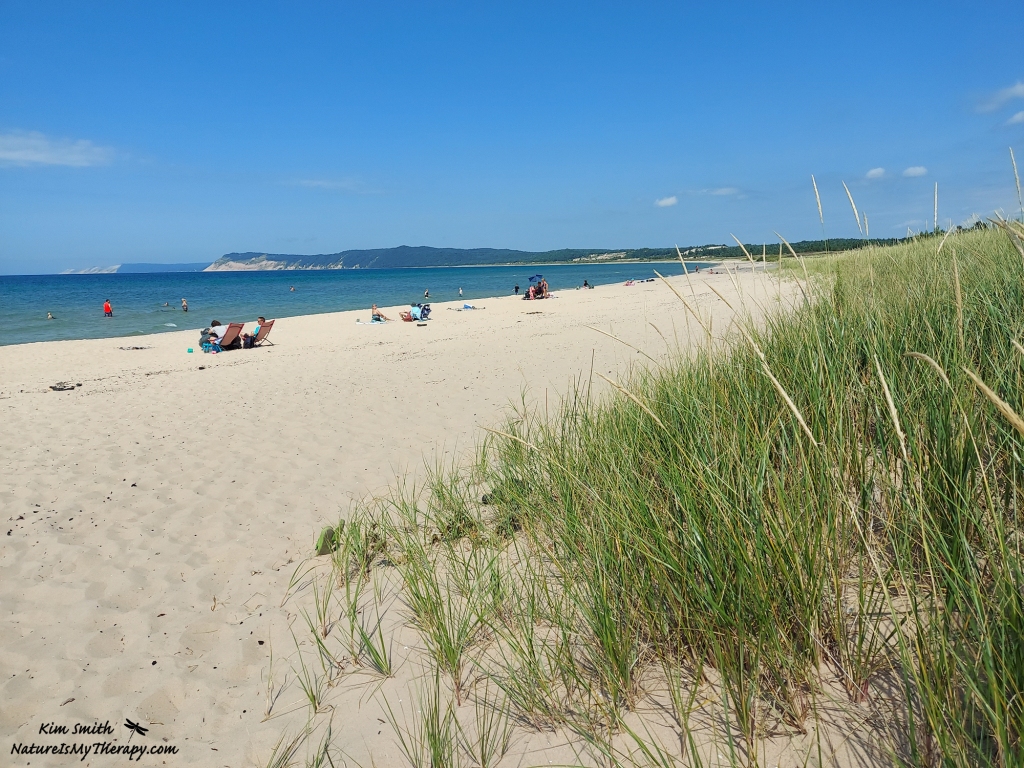
I lived in Michigan for 15 years, and somehow never managed to get to the Traverse City area, despite knowing that it’s one of the most popular vacation spots in the state. And now that I’ve been there, I can see why people rave about it. The Lake Michigan coast is stunning, and the view of Sleeping Bear Dunes is just lovely. I didn’t go to actually climb the massive dunes (as many do) but was content to admire them from a distance. (The only time I was on the beach was to snap a quick photo, and then I was off to look for more bugs and fewer people.)
There are two versions of the legend of Sleeping Bear; here’s one of them (click the link below the story for the other version):
Long ago, along the Wisconsin shoreline, a mother bear and her two cubs were driven into Lake Michigan by a raging forest fire. The bears swam for many hours, but soon the cubs tired. Mother bear reached the shore first and climbed to the top of a high bluff to watch and wait for her cubs. The cubs drowned within sight of the shore. The Great Spirit created two islands to mark the spot where the cubs disappeared and then created a solitary dune to represent the eternal vigil of mother bear.
National Park Service, https://www.nps.gov/slbe/learn/kidsyouth/the-story-of-sleeping-bear.htm
There are 100 miles of hiking trails throughout the enormous park, along with many campgrounds and vacation rentals. I would have explored some of the trails on a longer stay, but this trip was just my introduction to the area, and I didn’t want to exhaust myself trying to do too many things in a short time. I was happy to spend a few hours each day visiting nature preserves to photograph birds and insects, then returning to the house to enjoy some peaceful relaxation.

Before I arrived, my gracious host had visited some nature preserves that were new to him, just so he could give me notes about a few places I might look for dragonflies. I was blown away by the effort he’d made to provide me with everything I could possibly need during my stay.

One of Dave’s recommended nature spots was Arcadia Marsh Nature Preserve: “The blue vervain was spectacular. This is a place you need to see!” And he was so right about that. The vervain was in full bloom along the boardwalk edges, and teeming with insect life. Arcadia Marsh reminded me of some of the Lake Erie marshes near my home in Toledo. I spent two gleeful hours there before I even thought about the passage of time. I’d arrived a bit early for much dragonfly activity, but by the time I left there were lots of Twelve-spotted and Widow Skimmers flying around the marsh. I’ve been having trouble with my camera focusing on flying bugs, so I was happy when I found a very unusual cluster of a bunch of skimmers all perched together. See how many dragonflies you can find in this picture — I found six Twelve-spotted and one Widow Skimmer.
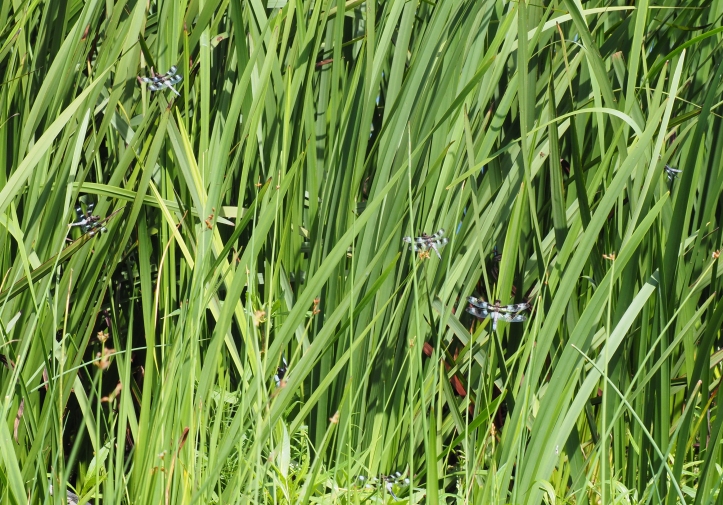
I have a particular affinity for hover flies, with their brown and black patterns that give them a superficial resemblance to bees. These bee mimics have a habit of landing on human arms to drink our sweat, and therefore many people think they’re sweat bees. The blue vervain was hosting incredible numbers of hover flies, and at first I thought they were a species I see often at home, the Narrow-headed Marsh Fly (Helophilus fasciatus). But no, these were a new species for me! The males and females look very different from each other, and that also confused me at first. These are the Long-nosed Swamp Fly (Eurimyia stipata), and if you look at the face on the male, you’ll see that their name was well-chosen. (You may have to click/enlarge the pic to see that detail.)


I was excited to see a near-miss predator-prey interaction during which several cedar waxwings tried to grab a green darner in mid-air. I saw one of them hit the dragonfly, but she evaded capture and quickly dropped down into the safety of the marsh vegetation. And luckily for me, I was standing only a few feet away and was able to get a shot of her as she rested and planned her next move. She didn’t appear to have any damage to her wings or body, so I imagine she eventually flew again when the coast was clear. By this time the boardwalk had gotten quite busy, so I was able to show the dragonfly to a couple standing near me. They were from Springfield, Illinois, on their way to Columbus, Ohio to see a special lighted exhibit of Chihuly glass sculptures at the Franklin Park Conservatory. We had a nice chat about insects and art glass and then went our separate ways. As much as I enjoy being on my own, I always enjoy having a chance to share nature with other people.
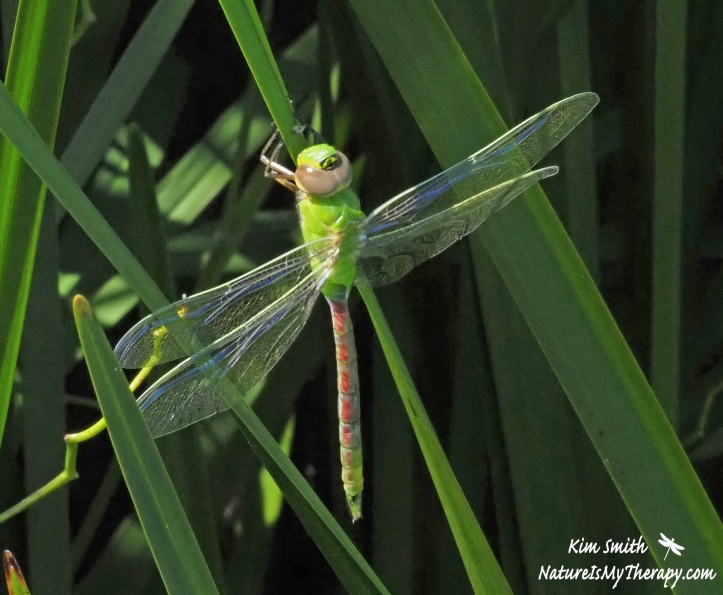
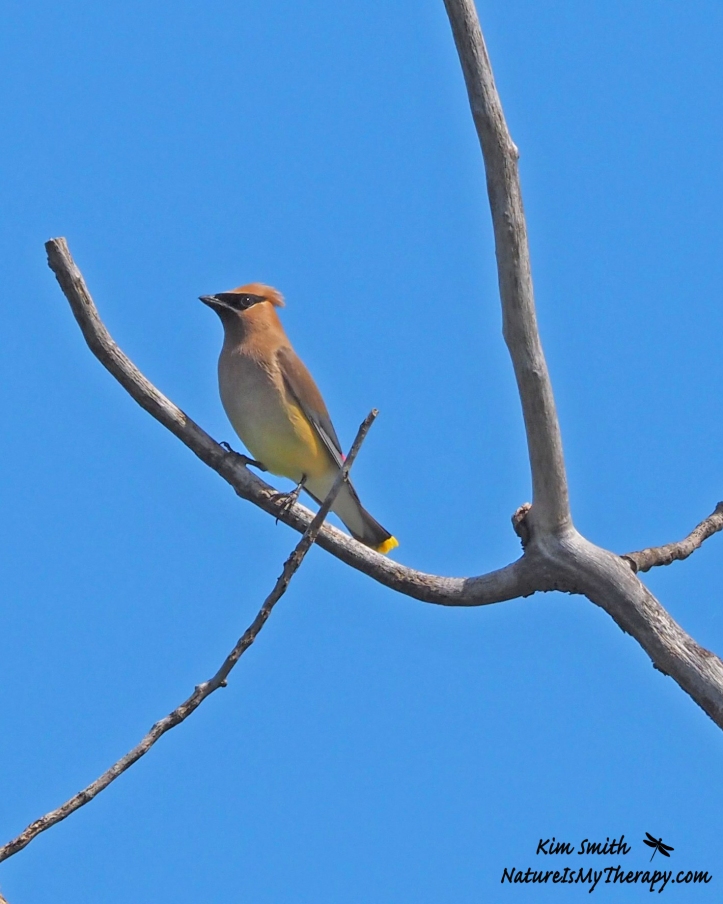
I enjoyed the near-constant chattering of several Belted Kingfishers (Megaceryle alcyon) as they moved around the marsh. One pair seemed particularly interested in each other, and they almost came within range for me to get good photos. Almost.
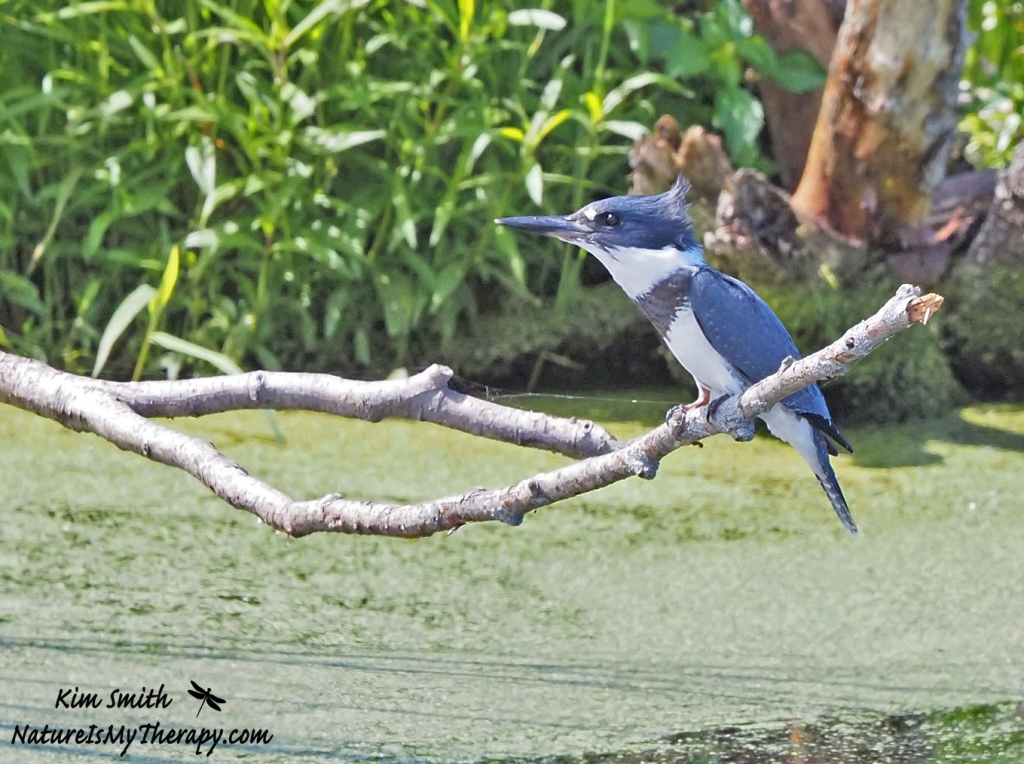
And then there were three Green Herons (Butorides virescens) hunting in the shallow water along a small peninsula. These small herons are so fascinating to watch, as they stalk their aquatic prey with almost undetectable movements for seemingly forever, then suddenly the long neck shoots out and grabs a victim who doesn’t even see it coming. If you’d never seen these birds before, you’d wonder where that neck comes from, as they keep it folded (or tucked or retracted or somehow unnoticeable…) until it’s needed.



Back at the house I photographed lots of insects, mostly congregating on the common milkweed (Asclepias syriaca) beside their garage. There were milkweed beetles, milkweed bugs, false milkweed bugs, milkweed tussock moth caterpillars, and more. One of my favorite finds was this scorpion fly (Panorpa genus); the male would have an abdomen that curls up at the end (like its namesake), so I think this is a female:
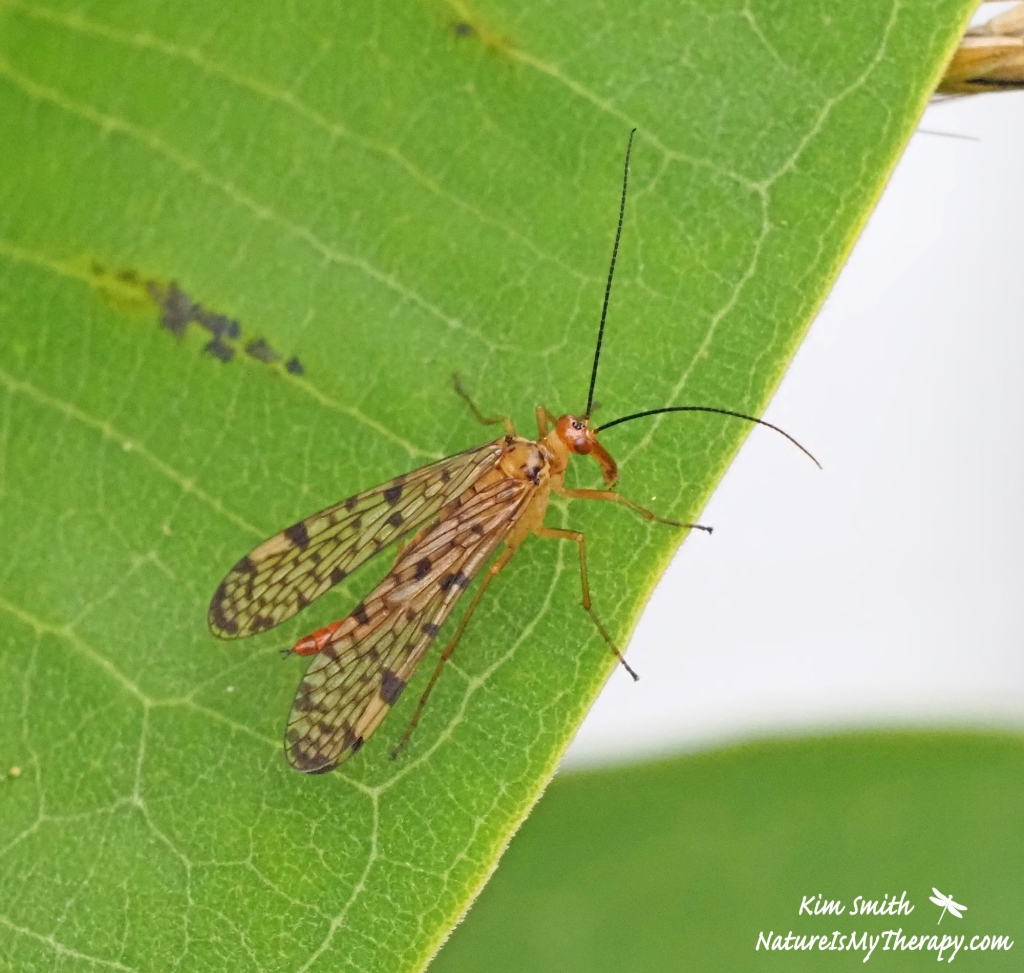
Isn’t she gorgeous? And then my overwhelming favorite, and a lifer insect for me, was this crazy Partridge Planthopper. I dare you not to gasp when you look at it!
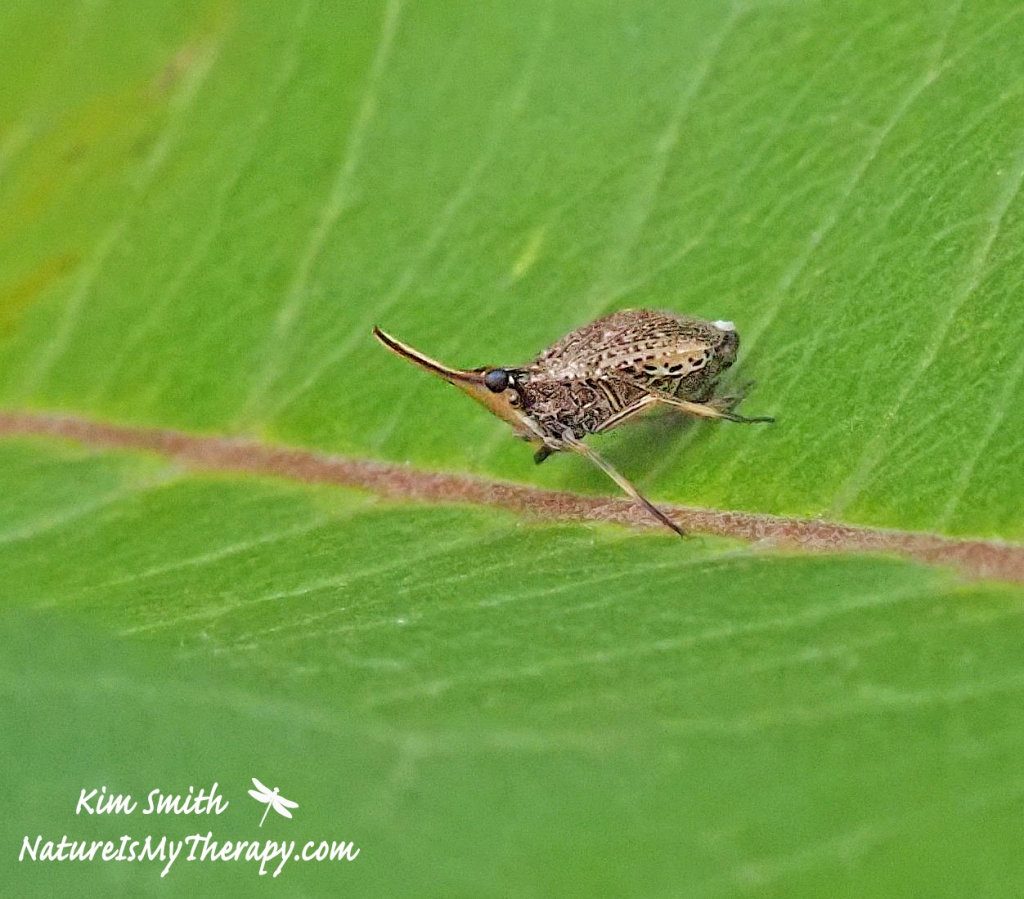
Planthoppers are interesting, but very tiny and usually fast-moving bugs, making it a challenge to get good photos of them. This one is about a quarter of an inch long (6 mm), and it didn’t give me much time to try for a better shot. But my gosh was I pleased when I zoomed in on my camera’s LCD screen and saw how stunning it was. Planthoppers are true bugs, with mouthparts designed to suck fluids from their plant food sources. I wasn’t able to find much about this particular species, but I believe its proboscis is folded underneath the abdomen. The long “snout” is most likely not the mouth. (If anyone knows for sure, I’d love to have clarification.)
One of the ways I could tell that this home was much loved was by the existence of a little rock garden beside the deck, with a couple dozen brightly painted rocks depicting flowers, birds, and insects. Of course I hoped to find a dragonfly, and I did! Although he looks like he might have had a run-in with those cedar waxwings. If I’d had time (and motivation…and talent, LOL), I would have liked to make them a new dragonfly rock so that my favorite insects continue to be represented in their lovely garden.
I’m so grateful for my friend’s generosity in allowing me the use of this place when I really needed a getaway. I don’t think I’ve ever been to a spot where I felt such complete relaxation; having 20 acres to myself was a luxury that I may never experience again in my lifetime. From all the photos and mementos displayed in their cherished vacation home, I could tell that it’s been an important part of their family’s life for a long time. It’s funny, isn’t it, how a single place can be different things for different people? This special place has hosted many lively group gatherings, but I treasured the solitude and peace. So, to Dave and Pat and their family, I thank you for this experience, and for giving me my first memories of Up North.



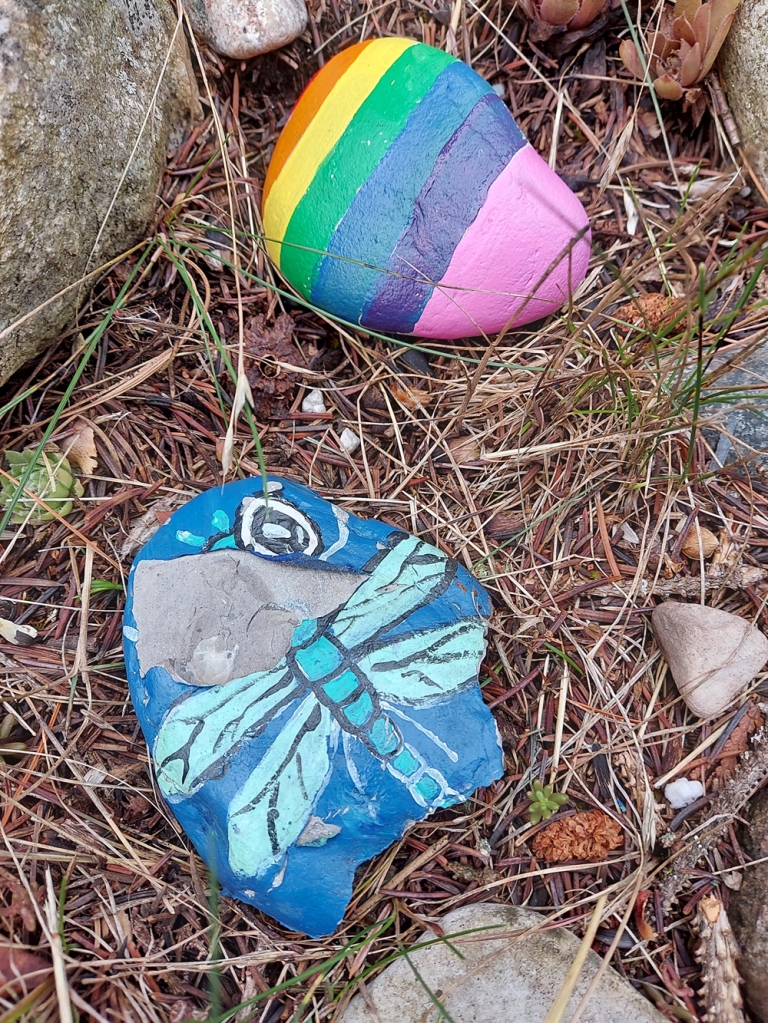
As you may know, we’ve been going to Northern Michigan for 25 years and I’m so pleased to look at it through your eyes and see all the wonderful insects I never see. I need to look more carefully! I love the Partridge Planthopper!
LikeLike
Yes, it sure seems that my eyes see the world much differently than most people, LOL. And that partridge planthopper was one of my favorite things from the entire trip. I just wish he’d allowed me to watch him for a few more minutes. Thanks for taking the time to read and comment, my friend.
LikeLike
Just getting to this. It sounds wonderful, and you definitely need a longer visit! Or a visit at another time of year.
LikeLiked by 1 person
Yes, I should go back to explore more!
LikeLike
Enjoyed all the pretty insects and birds. Such a beautiful place to visit and hope you get another invite to do it again!
LikeLiked by 1 person
I love the bugs too, and many people give me funny looks! Insects are fascinating! Love your blog!
LikeLiked by 1 person
Thanks, Sally! If people only knew what they’re missing by not paying attention to insects, right?
LikeLike
So glad you had this getaway! YAY! Gorgeous photos!
LikeLiked by 1 person
Thanks, Cindy, me too!
LikeLike
This was such a fun little virtual trip to take today; thank you!
LikeLiked by 1 person
Glad you enjoyed it, Jean!
LikeLike
That was a really terrific vacation. I can relate to your never having been in this area before, even though you lived in Michigan for 15 years. I’ve lived in Pennsylvania since the mid-1970s, and there are many, many sections I’ve never been to. I should do something about that!
LikeLiked by 1 person
Thanks, Neil. I’ve moved around a lot in my life and I notice that I’m always excited to explore my new home area… but it’s surprising how fast that wears off and we take things for granted. Maybe we should occasionally pretend to be tourists in our own cities.
LikeLiked by 1 person
Lovely post Kim! You are so knowledgeable about bugs, birds and plants. That vervain would be special to see en masse. I would have enjoyed a place like that too, so glad you had the opportunity.
LikeLiked by 2 people
Thanks, Ardys! I almost included a picture of the masses of vervain but the photos just didn’t do it justice. I’ve tried to grow that plant in my garden but it apparently needs more moisture than I have here. It looked pretty last year but didn’t come back this year. Thanks for the comment, hope you’re doing well.
LikeLiked by 2 people